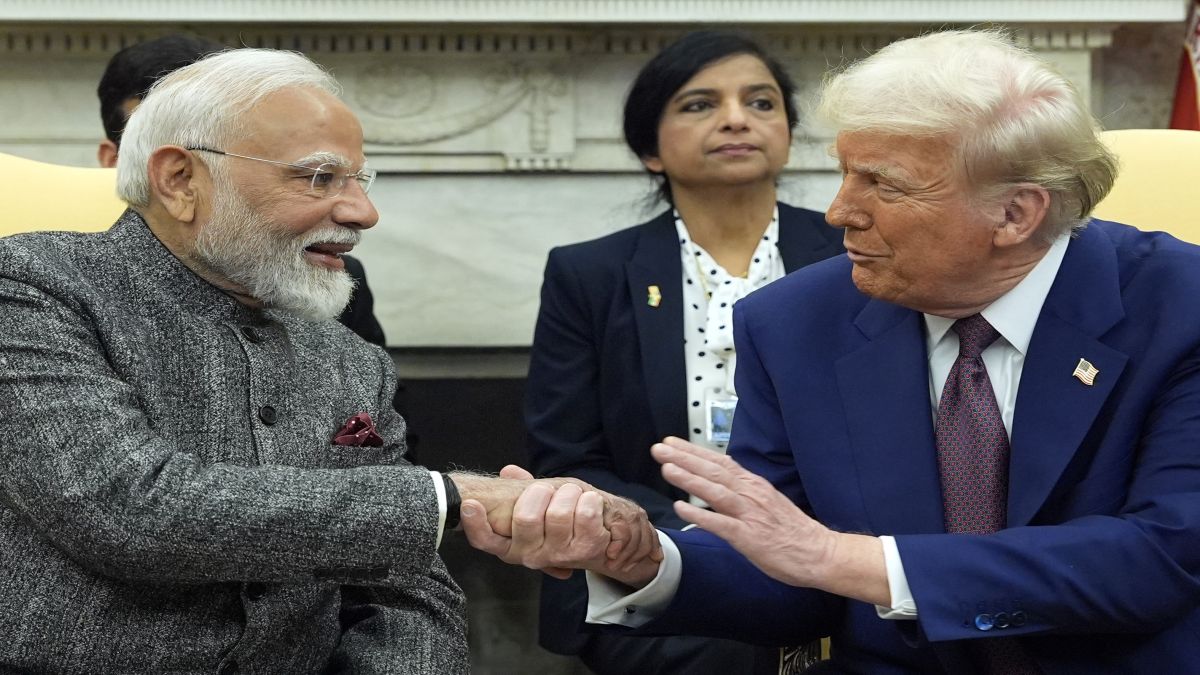US President Donald Trump has expressed optimism about a possible bilateral trade deal (BTA) with India.
Though there are reports that the trade deal might be finalised this week, the two sides are said to be apart on key issues including agriculture.
Trump, who had initially imposed reciprocal tariffs on dozens of countries including a 26 per cent levy on India on April 2, had issued a 90day-pause in order to allow countries to negotiate.
But with the July 9 deadline is drawing nearer and nearer, India and the US have still not reached a deal.
But what did Trump say? How is the India-US trade deal shipping up?
Let’s take a closer look:
What Trump said
First let’s take a brief look at what Trump said.
Trump said he thinks the United States and India would reach a bilateral trade agreement.
“I think we are going to have a deal with India. And that is going to be a different kind of a deal. It is going to be a deal where we are able to go in and compete. Right now, India does not accept anybody in. I think India is going to do that, and if they do that, we are going to have a deal for much less tariffs ,” Trump said.
Trump’s remarks came after US Treasury Secretary Scott Bessent on Tuesday said that India and the US were “very close” on a deal.
External Affairs Minister S Jaishankar on Monday had expressed optimism about a deal being concluded.
“We are in the middle — hopefully more than the middle — of a very intricate trade negotiation,” Jaishankar said. “Obviously, my hope would be that we bring it to a successful conclusion. I cannot guarantee it, because there’s another party to that discussion.”
Trump in June said the deal with India was imminent.
“We have one coming up, maybe with India. A very big one. Where we’re going to open up India,” Trump said.
“We’re not going to make deals with everybody. Some, we are just going to send them a letter, say thank you very much… My people don’t want to do it that way. They want to do some of it, but they want to make more deals than I would do”, he added.
Now, let’s take a look at what we know about the negotiations.
How are negotiations going?
The Indian delegation led by chief negotiator Rajesh Aggarwal had landed in the United States on Friday.
The team, which is negotiating with US officials including those from the Office of the United States Trade Representative (USTR), has now extended its stay in Washington.
Both teams, mindful of the upcoming deadline set by Trump, were said to be in fierce negotiations over the BTA.
However, key sticking points remain.
New Delhi is said to be adamant about carving out protections for its dairy and agriculture industry.
This is out of consideration for the millions of farmers working on small landholdings across the country. This can also be both a politically and economically sensitive issue to navigate.
India, for those not in the know, has never opened up its dairy sector to a foreign competitor.
India is the biggest producer of milk in the world.
Experts also say any reduction in tariffs on dairy and agriculture could undermine India’s Minimum Support Price (MSP) system – which could be devastating to farmers.
However, the US negotiators seem insistent about opening up a new market for its agricultural products including genetically modified crops, apples, reducing tariffs on skimmed milk powder and poultry products.
India has been reluctant to allow genetically modified crops to be sold out of health concerns.
India has banned the commercial cultivation of genetically modified crops.
Washington, which is looking to bring down its $54 billion trade deficit with New Delhi, wants to export maize, soya bean, cotton and corn to India.
India has told negotiators reducing tariffs on skimmed milk powder and poultry would hurt its small farmers.
Indian officials have described the dairy sector as a “red line” that cannot be crossed.
They earlier insisted that India’s national interest will come first in any deal.
The US also wants large-scale commitments from India to buy Boeing aircraft, choppers and nuclear reactors.
Washington may also pursue trying to get India to relax its FDI rules – which would benefit US behemoths such as Amazon and Walmart.
Officials say that India can likely bring down tariffs for ethanol, almonds, apples, raisins, avocados, olive oil, spirits and wines.
New Delhi, on the other hand, wants the United States to reduce levies on auto imports and Indian steel.
India also wants preferential access for its labour-intensive exports, such as textiles and garments, gems and jewellery, leather goods, and agricultural products like shrimp, oilseeds, grapes, and bananas.
Officials say that these will not likely hurt those selling these products domestically in the US.
Though the government think tank Niti Aayog had in a working paper in May suggested that India can relax tariffs on “soybean oil imports”, that paper has now been taken offline – which raises many questions.
India remains the world’s biggest importer of edible oil.
Officials say that reducing tariffs on maize and soybeans would hurt Indian small farmers.
Similarly, bringing down tariffs on maize would result in the production becoming unfeasible for local farmers.
If talks don’t pan out, India will likely face a 10 per cent across the board levy rather than the 26 per cent tariff Trump imposed.
But experts say a ‘limited trade pact’, like the one the US and UK announced on May 8, is likely.
Prime Minister Narendra Modi and Trump in February had agreed to increase bilateral trade, which was at $262 billion in 2024, to $500 billion by 2030.
With inputs from agencies


)

)
)
)
)
)
)
)
)



